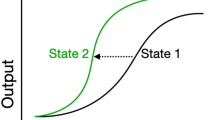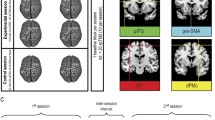Abstract
Actions are selected in the context of environmental demands and internal goals. Since both change continuously it is often necessary to inhibit a prepared action plan in favour of an alternative, a process we refer to as action reprogramming. Previous studies have established that a frontal/basal ganglia network exerts top-down control over the primary motor cortex (M1) during action reprogramming. The current study focuses on the role of M1 itself during action reprogramming. Participants were asked to perform a behavioural task that required them to either execute a prepared response or to reprogram an alternative response. Paired-pulse TMS was used to investigate short-interval intra-cortical inhibition (SICI) during these action execution and action reprogramming trials. Normal action execution was associated with sustained SICI in the M1 during both trials in which the contralateral hand was to respond and trials in which the ipsilateral hand was to respond. In contrast, reprogramming towards an alternative action was associated with a progressive release of SICI in M1 involved in the execution of the novel response. This release started 125 ms after the cue telling the participants to reprogram their action. This time point is consistent with previous results showing a facilitatory influence of the pre-supplementary motor area (pre-SMA) on the M1 at the same delay. Hence, SICI might be a potential candidate mechanism through which frontal lobe areas could influence primary motor cortex output.



Similar content being viewed by others
References
Aron AR, Poldrack RA (2006) Cortical and subcortical contributions to stop signal response inhibition: role of the subthalamic nucleus. J Neurosci 26:2424–2433
Aron AR, Fletcher PC, Bullmore ET, Sahakian BJ, Robbins TW (2003) Stop-signal inhibition disrupted by damage to right inferior frontal gyrus in humans. Nat Neurosci 6:115–116
Aron AR, Behrens TE, Smith S, Frank MJ, Poldrack RA (2007) Triangulating a cognitive control network using diffusion-weighted magnetic resonance imaging (MRI) and functional MRI. J Neurosci 27:3743–3752
Badry R, Mima T, Aso T, Nakatsuka M, Abe M, Fathi D, Foly N, Nagiub H, Nagamine T, Fukuyama H (2009) Suppression of human cortico-motoneuronal excitability during the stop-signal task. Clin Neurophysiol 120(9):1717–1723
Bestmann S, Harrison LM, Blankenburg F, Mars RB, Haggard P, Friston KJ, Rothwell JC (2008) Influence of uncertainty and surprise on human corticospinal excitability during preparation for action. Curr Biol 18:775–780
Buch ER, Mars RB, Boorman ED, Rushworth MF (2010) A network centered on ventral premotor cortex exerts both facilitatory and inhibitory control over primary motor cortex during action reprogramming. J Neurosci 30:1395–1401
Coxon JP, Stinear CM, Byblow WD (2006) Intracortical inhibition during volitional inhibition of prepared action. J Neurophysiol 95:3371–3383
Coxon JP, Stinear CM, Byblow WD (2009) Stop and go: the neural basis of selective movement prevention. J Cogn Neurosci 21:1193–1203
Duann JR, Ide JS, Luo X, Li CS (2009) Functional connectivity delineates distinct roles of the inferior frontal cortex and presupplementary motor area in stop signal inhibition. J Neurosci 29:10171–10179
Fisher RJ, Nakamura Y, Bestmann S, Rothwell JC, Bostock H (2002) Two phases of intracortical inhibition revealed by transcranial magnetic threshold tracking. Exp Brain Res 143:240–248
Frank MJ (2006) Hold your horses: a dynamic computational role for the subthalamic nucleus in decision making. Neural Netw 19:1120–1136
Hikosaka O, Isoda M (2010) Switching from automatic to controlled behavior: cortico-basal ganglia mechanisms. Trends Cogn Sci 14:154–161
Isoda M, Hikosaka O (2007) Switching from automatic to controlled action by monkey medial frontal cortex. Nat Neurosci 10:240–248
Kujirai T, Caramia MD, Rothwell JC, Day BL, Thompson PD, Ferbert A, Wroe S, Asselman P, Marsden CD (1993) Corticocortical inhibition in human motor cortex. J Physiol 471:501–519
Mars RB, Neubert FX, Rushworth MFS (in press) Top-down control over the motor cortex. In: Mars RB, Sallet J, Rushworth MFS, Yeung N (eds) Neural basis of motivational and cognitive control. MIT Press, Cambridge
Mars RB, Piekema C, Coles MG, Hulstijn W, Toni I (2007) On the programming and reprogramming of actions. Cereb Cortex 17:2972–2979
Mars RB, Klein MC, Neubert FX, Olivier E, Buch ER, Boorman ED, Rushworth MF (2009) Short-latency influence of medial frontal cortex on primary motor cortex during action selection under conflict. J Neurosci 29:6926–6931
Nachev P, Wydell H, O’Neill K, Husain M, Kennard C (2007) The role of the pre-supplementary motor area in the control of action. Neuroimage 36(Suppl 2):T155–163
Neubert FX, Klein MC (2010) What is driving inhibition-related activity in the frontal lobe? J Neurosci 30:4830–4832
Neubert FX, Mars RB, Buch ER, Olivier E, Rushworth MFS (2010) Neural interactions during action reprogramming and their related white matter pathways. Proceedings of the National Academy of Science USA 107:13240–13245
Reis J, Swayne OB, Vandermeeren Y, Camus M, Dimyan MA, Harris-Love M, Perez MA, Ragert P, Rothwell JC, Cohen LG (2008) Contribution of transcranial magnetic stimulation to the understanding of cortical mechanisms involved in motor control. J Physiol 586:325–351
Sinclair C, Hammond GR (2008) Reduced intracortical inhibition during the foreperiod of a warned reaction time task. Exp Brain Res 186:385–392
Sohn YH, Wiltz K, Hallett M (2002) Effect of volitional inhibition on cortical inhibitory mechanisms. J Neurophysiol 88:333–338
Stinear CM, Coxon JP, Byblow WD (2009) Primary motor cortex and movement prevention: where stop meets go. Neurosci Biobehav Rev 33:662–673
Vallssole J, Pascualleone A, Wassermann EM, Hallett M (1992) Human motor evoked-responses to paired transcranial magnetic stimuli. Electroencephalogr Clin Neurophysiol 85:355–364
van den Hurk P, Mars RB, van Elswijk G, Hegeman J, Pasman JW, Bloem BR, Toni I (2007) Online maintenance of sensory and motor representations: effects on corticospinal excitability. J Neurophysiol 97:1642–1648
van Elswijk G, Kleine BU, Overeem S, Stegeman DF (2007) Expectancy induces dynamic modulation of corticospinal excitability. J Cognit Neurosci 19:121–131
Wylie G, Allport A (2000). Task switching and the measurement of “switch costs”. Psychol Res 63:212–233
Ziemann U, Lonnecker S, Steinhoff BJ, Paulus W (1996) Effects of antiepileptic drugs on motor cortex excitability in humans: a transcranial magnetic stimulation study. Ann Neurol 40:367–378
Acknowledgments
This work was supported by the German National Academic Foundation (FXN), a Marie Curie Intra-European Fellowship (EIF) within the 6th European Community Framework Programme (RBM), a Royal Society International Incoming Short Visits grant (EO, MFSR), a Bourse d’excellence Wallonie-Bruxelles International (EO), and the Medical Research Council UK (RBM, MFSR).
Author information
Authors and Affiliations
Corresponding author
Rights and permissions
About this article
Cite this article
Neubert, FX., Mars, R.B., Olivier, E. et al. Modulation of short intra-cortical inhibition during action reprogramming. Exp Brain Res 211, 265–276 (2011). https://doi.org/10.1007/s00221-011-2682-3
Received:
Accepted:
Published:
Issue Date:
DOI: https://doi.org/10.1007/s00221-011-2682-3




